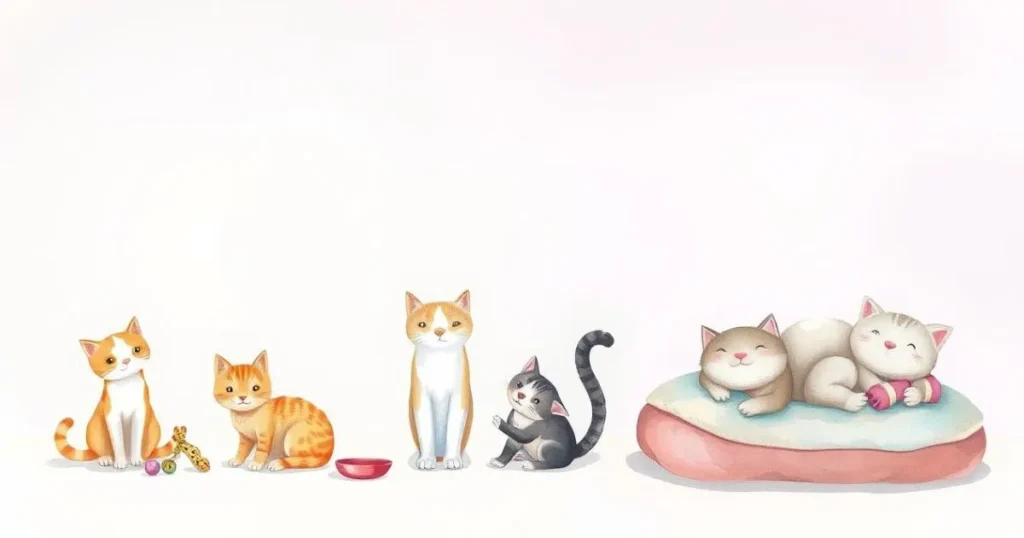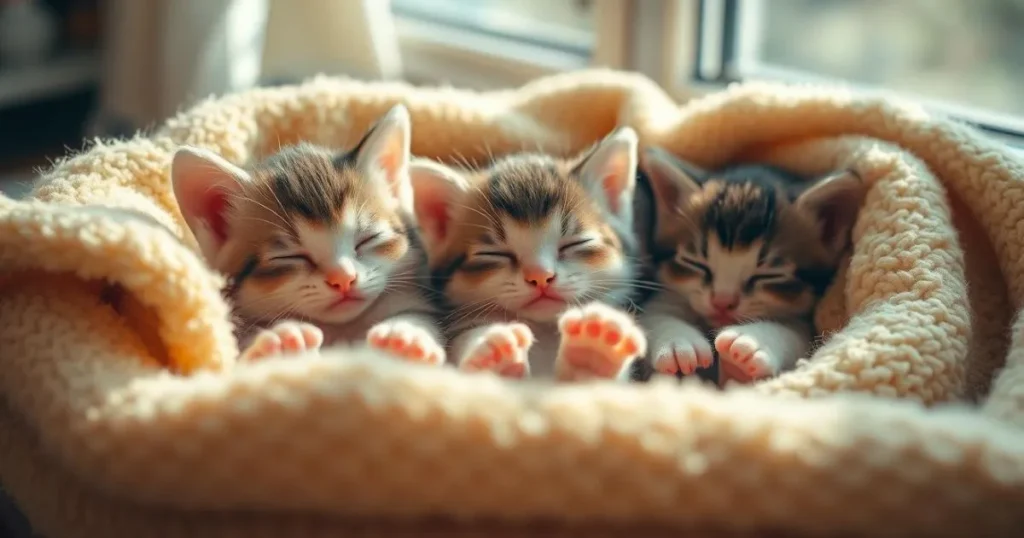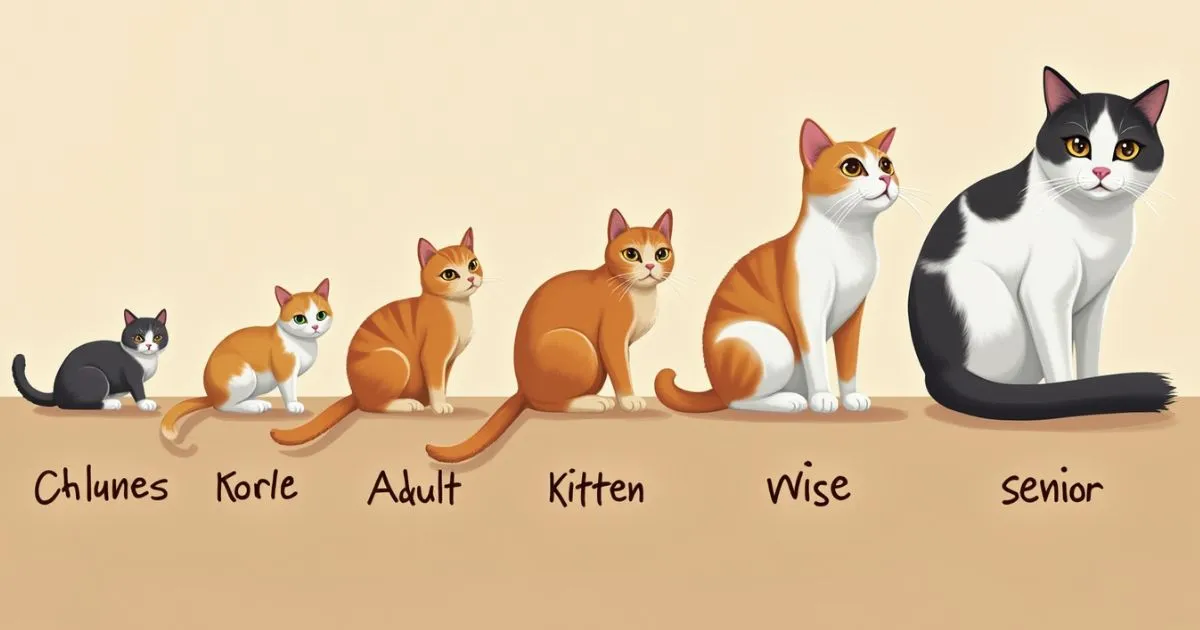Understanding the various phases of your cat’s life is essential for being a responsible cat owner. From the tiny kitten to the older cat, each stage has its own needs. This guide will cover all the stages of a cat’s life, with tips for keeping them healthy and happy.
Understanding your cat’s life cycle helps you care for them better at every age. Whether you’re new to cat ownership or have been for years, this article will help. It gives you the knowledge to care for your cat with confidence and love.
Table of Contents
Understanding the Feline Life Cycle: An Overview
As pet owners, knowing the life stages of a cat and the stages in a cat’s life cycle is key. It helps you give your cat the care they need at each stage. By understanding these stages, you can keep your cat healthy, happy, and well-cared for all their life.
Why Age Matters in Cat Care
Cats, like people, change a lot as they get older. The needs of kittens and older cats differ greatly. It’s important to change how you care for them based on their age and development.
Key Milestones in Feline Development
Cats go through many life stages, each with its own milestones. From the first days of life to the later years, knowing these stages helps you care for them best.
How Cats Age Compared to Humans
One year in a cat’s life is like 4-5 years in a human’s. Cats grow up, get older, and become seniors much faster than people. Recognizing these differences enables you to adapt to their evolving requirements.

By understanding each stage in a cat’s life cycle, you can make sure your cat has a great life. Tailoring your care to your cat’s age and development ensures they get the best support at every life stage of a cat.
The Newborn Kitten Stage: First Four Weeks
The first four weeks of a kitten’s life are very important. As a new cat owner, knowing what newborn feline life cycle needs is key. This knowledge helps you provide your kitten with the best possible start.
Newborn kittens need constant care and special attention. Their eyes open between 7-10 days. They start to play with their siblings and the world around them. Feeding is crucial, as they only get milk from their mother at this time.
- Ensure the kitten’s environment is warm, comfortable, and free from drafts.
- Monitor the kitten’s weight gain and feeding patterns closely.
- Avoid separating the kitten from its mother and siblings before 8 weeks of age.
- Consult your veterinarian for guidance on any health or developmental concerns.
Kittens grow fast during this time, developing their senses, motor skills, and social behaviors. This early growth is crucial for their health and happiness. By giving them the right care, you can help them have a great life.

| Key Milestones | Typical Timeframe |
|---|---|
| Eyes open | 7-10 days |
| Ears open | 6-12 days |
| Begin walking | 2-3 weeks |
| Start to play | 3-4 weeks |
Nursing and Weaning Period: Weeks 4-8
As your feline friend moves into the nursing and weaning stage, watch their diet and social life closely. This 4-8 week period is key for their growth and moving into the next stages of a cat’s life.
Transitioning to Solid Food
Kittens start to leave their mother’s milk around 4 weeks. Start them on high-quality kitten food or moist food slowly. Watch how they take to it and adjust nursing and food amounts gradually.
Early Socialization Needs
- Kittens need lots of early socialization with people and animals.
- Positive interactions and new experiences help build their confidence and social skills.
- Spending quality time playing and cuddling strengthens the bond between you and your feline friend.
Health Considerations for Nursing Kittens
Nursing kittens need special care. Watch for signs of illness like diarrhea, vomiting, or tiredness. If you notice these signs, consult your veterinarian immediately, see your vet right away. Make sure they get their vaccinations and deworming on time during this important cat stages period.
| Milestone | Timeline | Care Considerations |
|---|---|---|
| Weaning Begins | 4 weeks | Introduce high-quality kitten food, monitor nursing time |
| Weaning Complete | 8 weeks | Kitten should be fully transitioned to solid food |
| Socialization Period | 4-8 weeks | Provide positive interactions, exposure to new experiences |
| Veterinary Checkups | Ongoing | Monitor for illness, ensure proper vaccinations and deworming |
Kittenhood: 2-6 Months
As your kitten grows from a newborn to a kitten, the next few months are full of excitement. They will grow fast, become more active, and start to show their personality. This time, from 2 to 6 months, is key for helping your kitten grow strong and healthy.
Your kitten will have lots of energy and want to explore and play. It’s important to give them lots of playtime and safe places to play. Engaging your cat in positive activities helps them channel their energy productively.
Good food is also very important during this time. Kittens need a diet full of protein, fats, and vitamins. Discuss your kitten’s dietary needs with your veterinarian to ensure they’re getting the right nutrition. As they get older, they will need to switch to adult cat food.
Training and socializing your kitten is also crucial. Use positive methods to teach them good habits, like using the litter box and responding to commands. Also, introduce them to different things to help them become confident and well-adjusted.
Understanding what kittens need during this stage helps them grow into happy, healthy cats. With the right care, your kitten will be ready for the next part of their life.
Cat Life Stages: Juvenile Period (6-12 Months)
As your cat grows from a playful kitten to a young adult, the 6 to 12 months mark is key. This stage is full of physical and behavioral changes. During this period, your cat relies on you for consistent care and attention.
Physical Development Milestones
By the juvenile stage, your cat will almost be their full adult size. While they’re developing, their bones and muscles are still maturing. A balanced diet is crucial to support their development.
Behavioral Changes to Expect
- Increased independence and exploration
- Playful and energetic behavior, often involving rough-housing and chasing
- Potential for hormonal changes and the onset of sexual maturity
Your cat may show new behaviors during this time. They need patience and understanding. Adequate playtime and a safe environment help them grow well.
Essential Vaccinations and Care
It’s important to keep up with your cat’s vaccinations and vet visits during the juvenile period. Core vaccinations like feline distemper and rabies are key. Good dental care and grooming also keep your cat healthy and happy.
| Vaccination | Recommended Schedule |
|---|---|
| Feline Distemper | Every 3-4 weeks from 6-16 weeks of age |
| Rabies | First dose at 12-16 weeks, then annually |
| Feline Leukemia Virus | Two doses, 3-4 weeks apart, then annually |
Understanding your cat’s needs during the juvenile period is crucial. It helps them grow into a healthy and happy adult.
Young Adult Stage: 1-6 Years
As your cat grows into the young adult stage, from 1 to 6 years old, keeping them healthy is key. This is a prime time in their life, where they are at their best physically and mentally.
Preserving Peak Health
Regular vet visits, preventive care, and health management are vital during this stage. Make sure your cat gets all their shots, stays protected from parasites, and watch for any health issues.
Exercise and Environmental Enrichment
Young adult cats are full of energy and love to explore. Give them lots of chances to play, like with toys, scratching posts, and playtime. Keeping your cat mentally and physically stimulated reduces unwanted behaviors and keeps them content.
| Activity | Recommended Duration |
|---|---|
| Interactive Play | 15-20 minutes, 2-3 times per day |
| Puzzle Feeders | 30 minutes per day |
| Vertical Scratching | Multiple sessions throughout the day |
Creating a fun and stimulating environment is crucial. It helps your young adult cat stay happy and healthy during this exciting time.
Understanding your cat’s needs at this stage helps you care for them better. This ensures they stay healthy and happy during this exciting part of their life.
Prime Adult Years: 7-10 Years
When your cat reaches its prime, keeping it healthy is key. This stage, from 7 to 10 years, is when cats are at their best. By knowing what your cat needs, you can help it stay happy and healthy.
Maintaining Peak Health
Routine vet check-ups and early health screenings are crucial for their wellbeing. Make sure your cat gets dental cleanings, shots, and parasite control. Also, keep up with grooming and provide a safe, fun place to live.
Exercise and Environmental Needs
- Play with your cat often to keep them active and happy.
- Give them different toys and places to climb to keep them busy.
- Make sure their home is clean, comfy, and safe.
Diet Adjustments for Adult Cats
As cats get older, they need different food. Work with your vet to determine the ideal diet for your cat’s specific needs. They can help you choose the best diet for your cat’s health at this age.
Senior Cat Care: 11-14 Years
When your cat reaches their senior years, between 11 to 14 years old, their care needs change. It’s important to notice and adjust to the physical and behavioral changes of aging. This ensures they stay comfortable and happy.
Caring for senior cats begins with monitoring their health closely. Regular vet visits are key, as older cats face more health issues like arthritis and kidney disease. Your vet can help create a care plan to keep your cat healthy.
- Provide a comfortable, low-stress environment with easy access to food, water, and litter boxes.
- Introduce ramps or steps to help your cat reach favorite spots, and consider soft bedding to ease joint pain.
- Adjust your cat’s diet to accommodate any changes in their nutritional needs or digestive function.
As your cat ages, their social and behavioral patterns may change. Older cats may be less active and require extra care and affection. Adjusting your interactions and routines can help them enjoy their golden years.
| Age | Typical Feline Lifespan | Human Age Equivalent |
|---|---|---|
| 11-14 Years | Senior | 64-84 Years |
By focusing on senior cat care, you can make your cat’s later years comfortable and fulfilling. They deserve to live out their life with dignity and joy.
Geriatric Stage: 15 Years and Beyond
When your cat reaches 15 years or more, their health needs change a lot. It’s important to focus on their comfort and diet. This is a special time in their life.
Managing Age-Related Health Issues
Cats in their golden years may face health problems like joint pain or kidney disease. Regular vet visits are key. Your vet can help manage these issues and keep your cat healthy.
Comfort and Quality of Life
As your cat gets older, make their home comfortable. Add soft bedding and non-slip surfaces. This helps them move safely.
Play gently and bond with your cat. This keeps their mind active and happy.
Special Dietary Requirements
Older cats need special food. Their diet should help with kidney function and muscle loss. A vet can suggest the right food for your cat’s needs.
FAQ
What are the key stages in a cat’s life cycle?
A cat’s life cycle has several stages. First, there’s the newborn kitten stage from 0-4 weeks. Then, there’s the nursing and weaning period from 4-8 weeks. Next comes kittenhood from 2-6 months.
After that, there’s the juvenile period from 6-12 months. The young adult stage is from 1-6 years. Then, there are the prime adult years from 7-10 years. The senior cat stage is from 11-14 years, and the geriatric stage is 15 years and beyond.
What’s the best way to care for your cat through the different stages of their life?
At different stages, your cat’s care needs change. Newborn kittens need special feeding, warmth, and health checks. Kittens in the nursing and weaning period need a gradual food transition and early socialization.
Kittens need proper nutrition, play, and training during kittenhood. Juvenile cats need continued vaccinations and preventive care. Young adults and prime adults need exercise, enrichment, and a balanced diet.
Senior and geriatric cats may need care adjustments. This includes managing health issues and providing comfort.
How does a cat’s aging process compare to human aging?
Cats age much faster than humans. The first year of a cat’s life is like the first 15 years of a human’s. By 2 years, a cat is an adult.
Each year after that is like 4 human years. So, a 7-year-old cat is a senior, and a 15-year-old cat is geriatric.
What are the key milestones in feline development?
Key milestones in feline development include the opening of eyes and ears (around 1-2 weeks). Kittens can stand and walk by 2-3 weeks. Baby teeth erupt around 3-4 weeks.
They can regulate their body temperature by 4 weeks. The transition to solid food happens around 4-6 weeks. Kittens also go through socialization periods, behavioral changes, and physical growth spurts at various stages.
How can I ensure my cat’s health and well-being at each life stage?
To keep your cat healthy at each stage, provide age-appropriate nutrition, exercise, and enrichment. Regular veterinary visits, vaccinations, and preventative measures are vital for their health. Monitor your cat’s behavior, grooming, and physical appearance.
Address any concerns with your vet promptly.

